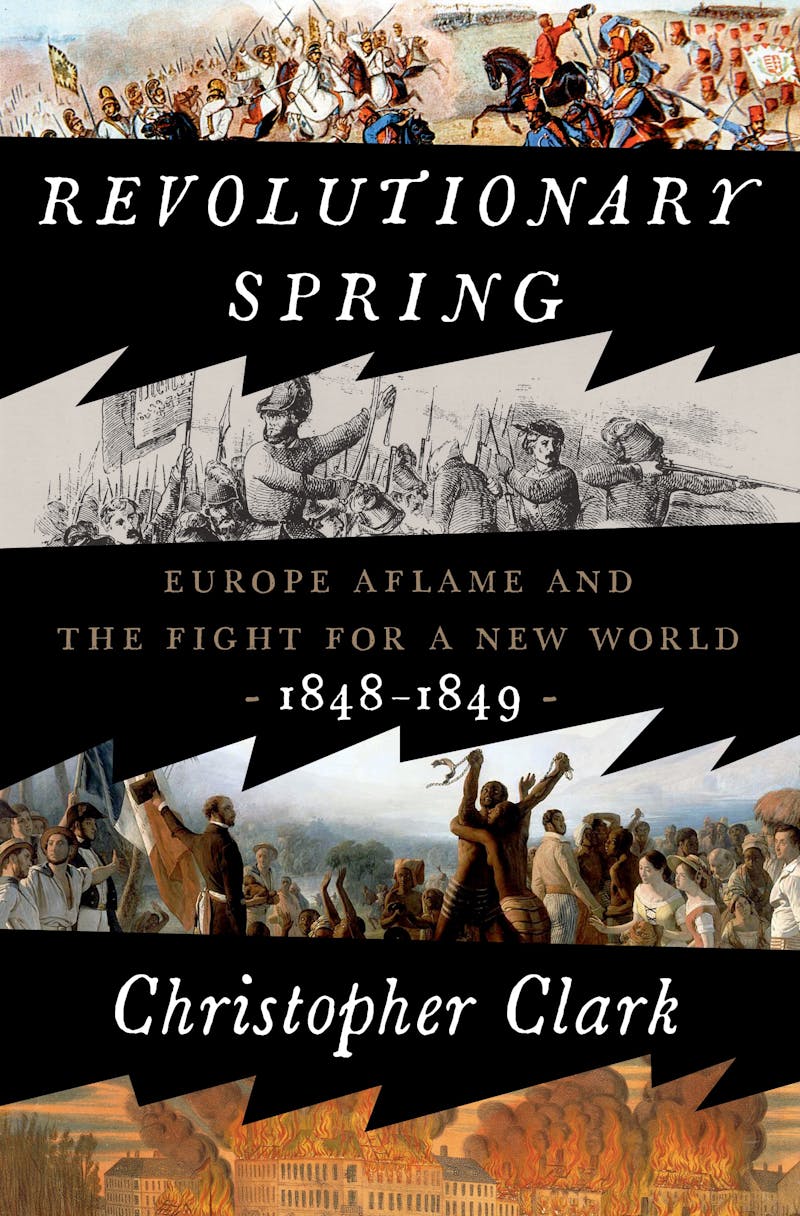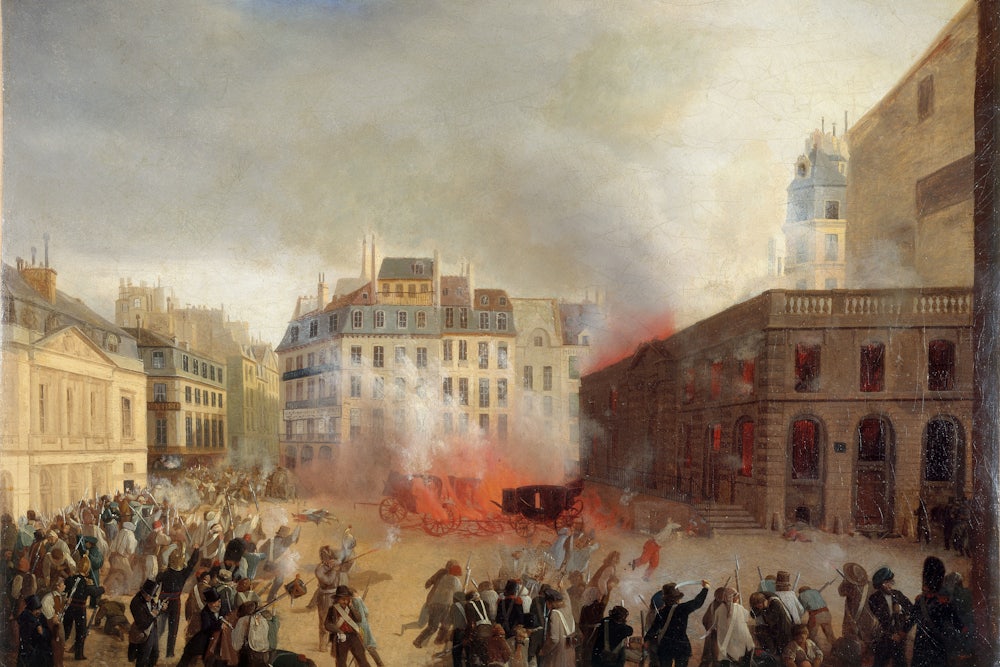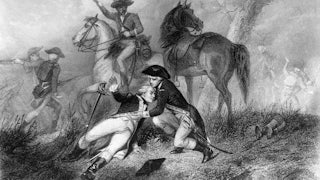What’s the best way to build a barricade? A carriage or wagon is a good start, heaved over to form a sturdy base. Next: Peel up the street cobbles and stack them any which way—so long as the bulwark is tall enough to hide a regiment of street fighters and a squadron of women with rocks in their aprons. For this rugged foundation, any old junk will do. Dining chairs, window shutters, gilt-edged chaises longues from the houses of the rich; bricks and lumber from warehouses; barrels from the local breweries (which can be quickly emptied—for courage, of course). Behind the parapet, weapons are an eclectic mix: blacksmiths’ hammers and butchers’ cleavers, perhaps an ancient shotgun or, if luck is on your side, a musket lifted from a slain soldier. All that’s left is to glance over at the faces of your comrades, pale with terror at their own daring.
Much of Europe went to the barricades in 1848—the first and last truly European revolution there has ever been. This seismic year, documented with panache by Christopher Clark in his authoritative new history, Revolutionary Spring, cracked open the “all-embracing system of tranquillity” regnant since the end of the Napoleonic Wars. In Paris and Prague, Vienna and Budapest, Berlin and Bucharest, public squares, cafés, and clubs gave Europe fresh constitutions and new parliaments, and a sense of the slate being wiped clean—the prospect of beginning the project of History over again. The continental uprising, Clark writes, was “the particle collision chamber at the centre of the European nineteenth century. People, groups and ideas flew into it, crashed together, fused or fragmented, and emerged in showers of new entities.”
Strange and diverse dreams brought them there. For the moderate liberal in his top hat and frock coat, here was a chance to overturn the monarchies that sat so heavily on top of every society and usher in a new regime of virtue and merit, of free trade and fair exchange. The radicals had coarser, wilder ideas: that every man (and maybe every woman too) should have the vote, that the press censor should be dunked in the river with stones tied to his ankles, that something should be done for the workers—something more than letting them rot in their hovels. The workers spoke for themselves, engaging in unbridled rebellion against this terrifying new machine called capitalism that stripped them of all pride, which the French socialist Louis Blanc called “a system for the extermination of the people.”

The collision chamber of 1848 hardened these varied and often eccentric theories about how to change the world into solid and coherent political blocs. Our understanding of conservatives, liberals, radicals, and socialists was formed in the crucible of revolution. Nationalism too exploded as a potent, undimmable force to challenge the ancient imperial order. For those enslaved at the periphery of that imperial world, the yawning difference between legal emancipation and the full meaning of liberation was clarified all over again. And the experience of men’s mockery at their cries—for the vote, for recognition, for the most basic dignities—girded isolated groups of feminists for the combat to come. Put another way, 1848 was the breech birth of the modern world. It arrived roaring and ashen with gunpowder, holding high the magical documents of a new epoch.
The ink was not yet dry before they were torn up. The barricades had barely been assembled when they were shattered. And, for all its thrill and excitement, 1848 has not left the same impression on the public imagination as 1789 or 1917. The bite of failure still clings to that year, and as Eric Hobsbawm once put it, “Historians, like politicians, tend to shy away from failure, unless it can be transmuted into heroic myth.” Revolutionary Spring rescues that crucial moment when possibility was cracked open; Clark also looks unflinchingly at the methods used to weld that crack shut. He shows that instead of producing hot and immediate change, the lasting outcome of 1848 was cool and slow transformation—a longer-term set of underappreciated consequences. Even as conservatives believed themselves to be restoring the old power, circumstances had been decisively shattered. Nobody emerged from 1848 unscathed.
The Revolutions of 1848 were shocking but hardly unexpected. Hunger lashed the mid-1840s with a doubly deadly grain and potato crisis (Clark’s ancestors were among the many thousands who fled Ireland for Australia). Yet hunger alone does not spark a sustained assault on political order. Destitution, Clark notes, was “more likely to render people ‘speechless’ and inactive than drive them to concerted action.” Tension had been steadily building across Europe. In the winter before the storm, the atmosphere was so charged that in the Sicilian port of Palermo a series of posters pasted to city walls predicting a revolution was enough to spark an uprising.
Behind their self-assured façades, the old regimes were proving precarious. When the French King Louis Philippe—installed after a revolt in 1830—tried to shut down the banquets liberals used as their campaign platform, all of Paris turned out against him. Over the border, south German provinces with a long history of republican agitation burst into general insurrection. Across the Habsburg lands—Hungary, Bohemia, Wallachia, and Galicia—small cliques of revolutionaries took the chance to openly declare for rights and privileges on the basis of their own emerging sense of nationhood, and even demanded outright independence. In divided Italy, Milan rebelled while Venice announced itself a republic. The Prussian king fled Berlin; the Austrian emperor escaped from Vienna. Between February and March, powers that had seemed so permanent and immovable were running for their lives. Klemens von Metternich, once the honoured architect of European reaction, left the Austrian capital for London a blind, decaying, defeated man.
In capitals across the continent there was a tremendous, breathless euphoria. History had ruptured. Anything was possible. The crowds on the boulevards in Paris were, one French politician wrote, as “naïve as the delirium of a child and as terrible as the frenzy of a giant.” Where had the victory come from? An alliance of the streets and the parlours, the barricade and the drawing-room, common cause made between liberal elites and insurgent radicals rising from the slum quarters. The early triumph of 1848 was an example of that rare thing in history: a coming together of antagonistic social classes.
It’s difficult not to be roused by Clark’s stylish narrative of this intoxicating opening phase. In the insurgent cities, provisional authorities formed in the offices of major newspapers, new Cabinets nominated by their editors and writers. In Paris, the staff of the liberal Le National joined with the more radical La Réforme to decide the immediate future of the country. From these interim bodies came a spree of diets, radas, national assemblies, and Reichstags—popular parliamentary bodies which, though still not decided by a truly universal franchise, represented a vast expansion of democracy in countries that had barely known the ideal at all. And from those parliaments came constitutions. Such an efflorescence of freedom marked the zenith of liberalism in 1848.
The radicals and socialists had done much of the heavy lifting to establish the legitimacy of these new governments, and sanctified the revolution with their own blood. They placed a nervous trust in the assemblies and charters, hoping that truly representative forums might bend the attention of deputies to the urgency of fixing social questions: They wanted relief for the poor, rights for workers, rescue from the ruins of unemployment. Their anxiety was quickly vindicated. As the first votes were returned and the new deputies took their seats in the spring of 1848, it became apparent that, as Clark puts it, the liberals would not continue the fight. Instead they were using their hard-won newborn institutions to spend weeks fiddling over the most impotent points of procedure. “Poetic gleam deserts them,” the German radical Franz Schuselka sneered while observing the inching tedium of the Frankfurt parliament, “and their height and greatness shrink considerably.” All the while, they ignored the building tumult and rage.
Their hesitancy was driven by a visceral fear of proletarian violence. Unlike their forebears of 1789, the moderates had a model on which to base their assumptions about how the revolution was supposed to turn out. They were self-consciously aware of the Jacobin terror 50 years earlier, and they did not flinch in deploying undiscriminating force against any whiff of a challenge from workers and radicals. In Vienna, the National Guard of taxpaying riflemen and the Academic Legion of beret-clad student guerrillas were called upon to stifle repeated risings from below. During the showdown of the June Days in Paris, provoked by the closure of the National Workshops (a kind of make-work scheme for the unemployed), deputies of the National Assembly were more than happy to crush a bewildered and frustrated left with extreme violence: Many of the 3,000 dead were captured then shot without trial. If the first stage of 1848 was the victory of a cross-class alliance, the whirlwind of the summer saw the rebirth of irreconcilable class hatred.
That summer, the forces of conservatism realized that the revolution was not as formidable as it first appeared. Social schisms were evident everywhere. Within the patchwork Austrian Empire, national revolts were splintering domains apart. If the Hungarian uprising had been the cause célèbre of the patriotic spring, it was quickly being challenged from within by other groups on territory the Magyar claimed for themselves: by Czechs, Croatians, Poles, and Ukrainians, all desiring their own liberation. Regrettably for the health and future of the revolution, both the Prussian and Austrian monarchs were able to escape with their armies intact and plan next moves. Their greatest friend turned out to be the laboring poor of the countryside.
From Calais to Kyiv, peasants made up between a half and two-thirds of the total European population, and they were overwhelmingly immune to the charm of the revolution. In October, on the eve of the Austrian counteroffensive, Emperor Ferdinand I was mobbed by a crowd of adoring farmers on a rural road. “In Vienna there are some people who have it in for me,” he cried out, his face wet with tears. “They want to seduce you.” The crowd roared their approval, their faith and loyalty firmly intact. And it was the rural French poor that delivered Louis Napoleon, the preening nephew of France’s last great leader, a massive supermajority in the presidential elections at the end of the year.
By the autumn of 1848, the old regimes were on the march—with the peasantry firmly behind them and bolstered by a vast Russian army. The result: immense repression. “It seems,” the German feminist Fanny Lewald mourned, “as though an iron net has been spread out over us and we are denied even the sight of the heavens.” With much of the French left imprisoned or exiled after the June Days, Louis Napoleon was not only secure in his own position; he was able to volunteer an expeditionary corps on the side of the pope to put down the exuberant but doomed Roman Republic. South German democrats fought a dwindling guerilla campaign. A final spasm of radical revolt in Vienna was blasted apart in tough urban combat. The Hungarians survived longest and battled hardest in a war of total mobilization that ended with the Austrian seizure of Budapest in July 1849.
The old regimes of Europe secured their victory by traditional methods. They won through “naked violence,” Clark writes, “the triumph of one force over another.” But this was a trick that could only be used once. Strict discipline and pure autocracy had governed the years between 1815 and 1848 and had won them an unsettled peace, yet such techniques would only rouse resistance in the future. For the next 30 years they learned to adopt a more thoughtful strategy of what Clark calls “carefully dosed counter-revolutionary prophylaxis.”
They threw out the constitutions issued in the name of “the people” and published their own charters finely machined to give the illusion of popular sovereignty while cloaking the retention of their power. Post-’48 regimes finally expunged the last residues of feudal economics and unleashed the transformative capacity of capital in a campaign of industrialization and railway-building, in the hope that a blooming economy might quiet down the rancor of the workers. Baron Haussmann’s boulevards in Paris and Vienna’s Ringstrasse were gigantic urban projects built as a monument to the productive power of the state, and as a way to make the building of barricades impossible. The press censor—for so long a malevolent presence in the lives of even the most pacific journalists—was largely set aside. Instead, the post-’48 regimes realised they could massage, corral, and manipulate public opinion rather than continually choking it. The real revolution was followed by a more modest revolution in administration, hand in hand with the telegraph, to bolster the authority of ministries and enact specific publicly declared policies and programs to improve the nation and glorify its resilience.
These profound alterations in European life were only possible after 1848, necessary for the establishment to reassert its grip on the neck of the people without squeezing too tight.
Clark writes that he was put off studying 1848 because he had been taught to regard it as a disappointment—a particularly bloody bump in the road toward progress. But as his book shows, dismissal is too easy, and “failure” is a misleading word. It suggests the revolutionaries, from radicals and workers to some well-meaning liberals, supported incoherent goals or that their cause collapsed because of innate flaws in their ideas. There was plenty of incoherence, sure, a great number of poor decisions, and too much backstabbing. Clark demonstrates that the better and more accurate term for 1848 is “defeat.” The Revolutions of 1848 were murdered: put down deliberately with overwhelming cruelty.
Defeat, however stinging, can be revelatory. Liberals found that 1848 exposed the vulnerability of their position (and of the concept of liberalism itself). As February and March had shown, they could never hope to overthrow an authoritarian ruler without the help of the lower classes. But when threatened from below, they had to make common cause with the very same conservatives they had sworn to challenge. For the radicals, 1848 proved that all the gorgeous, gleaming language of the age—justice, emancipation, liberty, solidarity—was nothing when faced with the sharp point of a bayonet.
A beautiful or bold idea could urge you to the barricade, but it could not, on its own, guarantee a victory. Life and death in 1848, Clark shows, depended on a brutal equation of power and violence, and as so often in the history of revolutions, those who run headfirst to the fight with only a few friends by their side and a swelling song in their chests are destined to meet the unassailable force of the state. “Grass has grown over them all,” Clark writes mournfully of the unremembered dead of 1848. The world built by their vanquishers—however crumbling and decayed it might seem now—is the one that endured.






